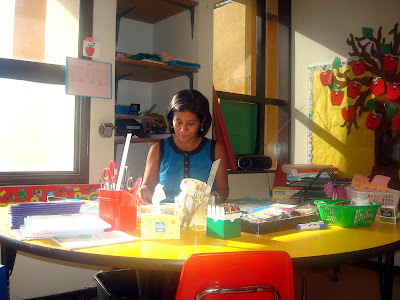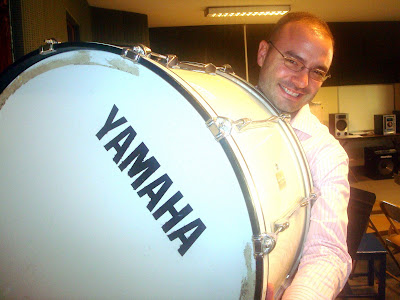Knights and Damsels Battle
For Honor, Glory -- and Fun
By Lucia Landivar
Maid Natalia of Medina representing the White House looked determined. But then so did Maid Naira of Rodriguez, who was fighting for the Black House, as they both charged down the track wearing cardboard horses on straps from their shoulders, and aiming long, white PVC “lances” at a small tire suspended above the track midway between them.
Both girls’ lances skewered the tire simultaneously and the two maids began a desperate struggle to take possession of it from the other. The two galloped together out onto the soccer field, each being urged on by their partisans.
“I’m scared,” said a sixth grade boy as the girls battled ferociously.
“I think it’s a little dangerous,” commented a worried Hudson Thurston, one of the teachers who organized the Medieval Day together with athletic director Alvaro Ludueña.
“This is definitely not baseball,” said Seth Gibson, another teacher who was helping to supervise.
Finally, Patrick St. Amand, the teacher in charge of the event, called a halt – just as eighth grade Natalia Medina broke free with the ring to the dismay of classmate Naira Rodriguez. There was a protest and a rematch.
“Whoa, I’m out of here,” said teacher-spectator Kirk Dahlberg, as soon as he heard about the rematch.
That was more or less the way it went throughout Medieval Day on Sept 21 when the Middle School students, divided into three “kingdoms” or “houses” (Black, Red, and White), spent a full day competing in games, contests, and competitions for best choreography, costumes, coats of arms, and royalty – all with a medieval theme. The competition was fierce, but all in fun.
“The main purpose of Medieval Day was to raise school spirit by sharing and having a good time between students from different grades, without leaving behind the opportunity to gain some knowledge out of it,” said Ludueña, who thought up the idea.
He wanted to build on the “House” systems implemented last year to improve the links of friendship between middle school classes, and give the middle school a more coherent identity. The medieval theme gave the event a twist that made it distinctive from the usual “sports days” of the past.
The “medieval” theme offered the opportunity for students to dress up as kings, queens, knights, and other characters of the medieval era, and participate in assorted competitions involving this era somehow. And it seemed to work. Roberto Maureria from 8th grade had been putting lots of effort over the preceding three weeks in making costumes out of recycled materials and designing a coat of arms on a banner that would lead the White Kingdom in battle. On the day of the event Maureria and his teammates were anxious for the games to begin. “I really do believe my house has a huge chance to win today” said Maureira.
His confidence was well placed. Although no one seemed to be paying much attention to the score during the day – they were concentrating more on having fun – the White House did win the overall award in results announced several days later, though not by much. White amassed 1600 points, winning six of the fifteen events including best coat of arms. The Red House was second with 1500 points, and victories in five of the events. The Black House trailed by a narrow margin, with 1350 points and wins in four events.
For the opening ceremonies the three houses paraded into the gymnasium in sequence while judges assessed the banners, coats of arms, mascots, dance routines, costumes, and general enthusiasm. Indeed, enthusiasm seemed more important than authenticity. The dances, for example, seemed to owe their inspiration more to Radio Disney than King Arthur’s Court.
“Medieval Fair” features games of a different sort
The rest of the morning consisted of groups of students representing each house rotating from one activity to another at various locations in the coliseum testing their ability to throw, hit, or toss assorted objects at various targets – all with a medieval theme. The model was the “fairs” of medieval times.
The knights and damsels were ready for action, cheering on their kingdom, sweating, and jumping up and down. “Faster, you can do it!,”one could hear shouted as the gym became one big chaotic battlefield. Some of the advice was specific: “Strike the eye of the dragon, and control that sword!” was the cry at one venue. Other admonishments were more general, such as “Hurry, hurry, hurry!”
The “towers” game was definitely a favorite between the students. Combatants from the seventh grade Red Kingdom described the game as “fun and creative, because we all had to figure out ways to carry as many boxes as our bodies could” across a plank “bridge,” and then into a cardboard “castle.” There the next player would have to pick them all up – and add more – as fast as possible and return. The trick was to stack the boxes systematically rather than carry them in a jumble.
“Hitting the dragon with the axes was so cool. We acted as if we were Cinderella, and the guys were our knights in shining armor. In the end we all laughed at our interpretations of princesses,” explained seventh grade girls while chuckling and giggling as they hurled cardboard rubber axes at a papier mache dragon’s head. (The axes and dragon were made in art class.) Teacher Rocky Canelas was in a frenzy trying to count the number of “hits” scored by the hail of axes.
“The horseshoe game was amazing, everyone got excited, and we all started shouted as loud as we could to cheer on the players. We did more physical work in this game, since the horseshoes were a little heavy,” said Raul Cabral from sixth grade. The goal of the game was to toss horseshoes into a metal paint bucket set on a gym mat: the bucket was half filled with sand to weigh it down and stabilize it, but it took a beating as did the gym mats.
Students also threw crowns, fired balls at targets using small catapults, and launched rubber-tipped arrows from miniature crossbows at fake mice. “We were always bickering about who went first in every game,” said excited eighth grader, Gilberto Chavez.
The finale of the games inside the coliseum was the “Save the Damsel” challenge. This game involved a small obstacle course that six knights from each kingdom had to walk and crawl through in turn to reach a cage composed of two small soccer goals lashed together with six cable bicycle locks. A “damsel” was imprisoned inside the goals. “Faster, use your arms!” screamed the knights of the Black Kingdom, as a brave fighter did a low crawl under a net, and arrived at a cage.
On arriving at the cage each knight had to overcome his nerves to figure out which lock his key would open. The knights often had to try each lock before he found the right one. Another complication was that the keys were on ribbons that tended to get enmeshed in the netting of the goals. Once the knight had opened his lock he had to run back to the beginning, and give the keys to the next courageous knight from his kingdom. The damsel was “freed” when all six locks were opened. The Red House won by completing the challenge in the shortest amount of time.
On to the Jousting Field
After a lunch break the afternoon events in the soccer field started. Sixth grader Jose Carlos Paz declared these “the best part of Medieval Day,” and many students seemed to agree. Paz at the time was wiping off shaving cream that represented his “wounds” from one of the events.
The first game consisted of a group of girls from each kingdom participating in a sand castle contest. Each group had 20 minutes to build a castle, which was judged by middle school teachers, Nancy Maya and Kirk Dahlberg.
Then came the most amusing event of the day, Damsel Jousting, started. (This was the game where Medina and Rodriguez had their clashes.) “It was one of the funniest and exciting competitions of the day!” said Jose Mario Zambrana from seventh grade. “Go, go, go, go, go,” shouted spectators on the bleachers as the pairs of maids charged toward one another. Cries of “Yes!” greeted each successful skewering of the small tire by a plastic pipe lance. Spectators shouted for victory or vengeance as the process of elimination advanced.
“This is more stressful than teaching,” said St. Amand, the organizer, as he strove to keep order.
After the Damsel Jousting came the almost equally entertaining “Knight Battles.” This competition consisted of two players from different houses standing on small platforms a short distance apart, and trying to knock the opponent off his platform with sticks that had cloth-covered sponges at each end. Each knight wore a helmet and hitting an opponent in the head was prohibited. The crowd shouted helpful hints to their teammates as to where to hit the opponent next.
“The battle was harder than it looked, but I was victorious,” said Lorenzo Monasterio from eighth grade after successfully knocking his opponent off the box.
Finally, the Knight Jousting competition took place. This was similar to the Damsel Jousting in that pairs of knights charged one another down a track, but this time the goal was to hit the opponent with a plate full of shaving cream. The knights wore protective glasses to keep the soapy foam out of their eyes.
“I was nervous that my opponent was going to get shaving cream on my horse, my body, or worse, my face,” said eighth grader Richard Salvatierra, whose horse did get a lethal splattering of foam. “I was sad when that happened, since I lost possible points for my kingdom,” he said.
Once the day was over, the staff and the students seemed satisfied with the outcome of the Medieval Day. Everyone had the chance to get away from the usual to experience a carefree day in which many new friendships were built, and many new things were learned. Many students and teachers did agree that t would be good to add some water games to future competitions if the weather was as hot next time. .
But at least the competitors hadn’t had to wear real suits of armor.



































